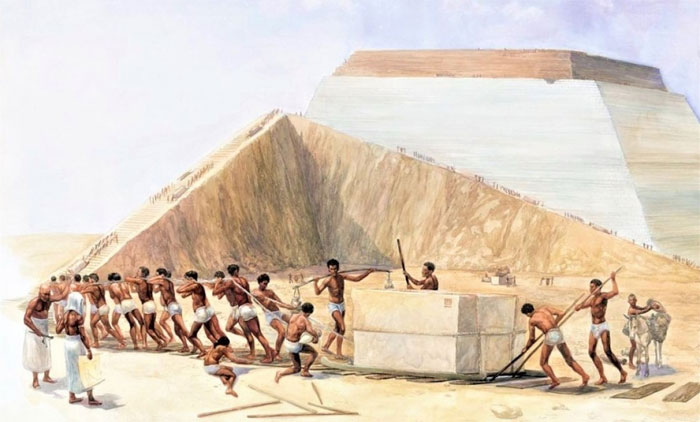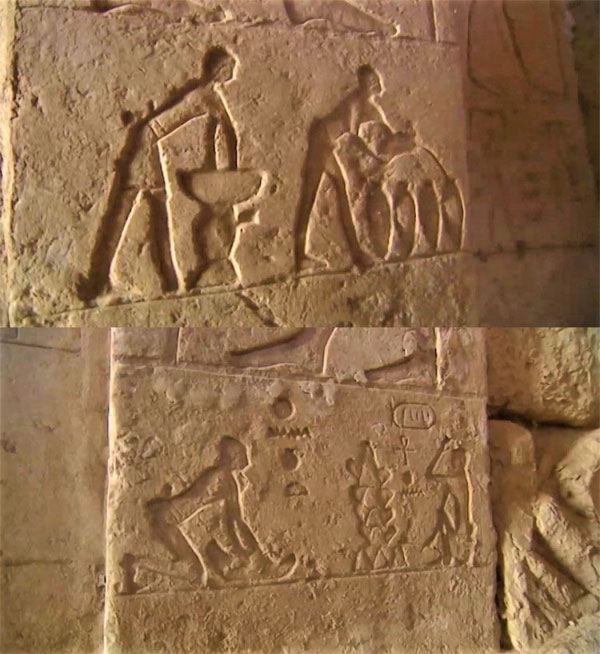In reality, the pyramids were not built by slaves, and there were not 100,000 people involved in their construction.
The ancient Greek writer, historian, and geographer Herodotus is often referred to as the “father of history.” His discoveries and written accounts have significantly shaped our understanding of the ancient world, including the belief that the pyramids were constructed by slaves.

Recent discoveries show that the pyramids were not built by slaves. (Source: Historyofyesterday)
However, recent archaeological excavations and modern science have proven this long-held belief to be false. The pyramids, the largest architectural structures in the world until the 20th century, were not built by slaves. The three pyramids of Giza, constructed in the third millennium BCE, showcase the best pyramid-building skills of ancient Egyptians.
Determining who built them has been called “one of the most important archaeological discoveries of the past 100 years.” During an excavation around the Giza pyramids, a digger struck a large block, which turned out to be the wall of a building. Archaeologists painstakingly explored and found large structures – a village dating back to 2000 BCE. The village spans over half a square mile.
It was determined that these were the homes where the pyramid builders lived and worked. Large bakeries were also found intact in the village. They were filled with hundreds of large clay jars used for baking bread, weighing up to 25 kg. These large clay jars are the first indicators of the production of the necessary amount of bread to feed a large workforce.
The chief archaeologist of the Giza Plateau, Dr. Zahi Hawass, explained how a second clue emerged when a woman riding a horse had her horse’s foot fall into a crack that revealed a wall made of bricks and mud. This was the wall of the tombs of the pyramid builders and their overseers. Of the 600 tombs discovered, they were divided into two levels. The lower-level tombs were very simple and contained only bones, pots, and tools of the laborers.
The “upper-level” tombs were more elaborately constructed and were the burial sites for the overseers and architects. These tombs were completely intact because thieves were not interested in them, as they were thought to contain no treasures. The walls of some tombs were inscribed with carvings. The inscriptions explain the process of pyramid construction as well as cooking, planning, and supervision carried out as part of the overall operation.
The bones in the tombs were later transferred to Cairo Medical School, where further groundbreaking discoveries were made. Among all the skeletons, 50% were male, 50% were female, and 23.6% belonged to children (even infants). This indicates that entire families of the pyramid builders lived around the pyramids. DNA analysis confirmed this theory. The discovery of family life shattered the theory that slaves built the pyramids, and subsequent findings further debunked that notion.
After further analysis of the bone fragments, scientists discovered instances of broken bones that had healed. Researchers compared the healed bones of workers to similarly healed bones of nobility and found that the victims received the same medical care. Healing broken bones in ancient Egypt required significant skill and time, which was not afforded to slaves. However, the pyramid workers received such special treatment.

The pyramids were built with far fewer laborers than previously estimated. (Source: Historyofyesterday).
When a worker suffered a broken bone, they would lie down and have their injuries examined. The doctor would then pull the broken arm or leg while an assistant held the healthy limb. This would reduce the fracture, and the wound would then be treated with an unidentified mineral, honey, and wrapped in linen. Honey was applied daily until the wound healed. The doctors in ancient Egypt were so skilled that they even successfully performed amputations.
However, advanced medical treatment was not the only benefit enjoyed by the pyramid builders. Their diet was also of high quality. While the common diet of Egyptians consisted mainly of bread, the discovery of fish bones and livestock bones indicates that the laborers consumed large amounts of meat. This also reflects that the workforce was well-fed and provided with the best food.
Although the pyramid builders were treated well, their lives were not easy. They lived ten years shorter than those of the nobility, and their bones showed signs of high stress.
Nevertheless, it is not true that 100,000 laborers were used and that it took 30 years to build the pyramids. Especially considering that 100,000 people would equate to 10% of the population of ancient Egypt. In reality, ancient Egypt only employed 20,000 people and took 20 years to construct the Great Pyramid of Giza, which includes 2.3 million stone blocks, each weighing up to 10 tons. Of those 20,000 workers, 15,000 worked 12 hours a day for three months and then returned to their villages. New workers would replace them. The remaining 5,000 were core workers and fixed technicians.
By conducting a large-scale experiment, American construction expert Craig Smith, who builds airports and subways, confirmed these numbers. Thus, the theory of using slaves in such numbers to build the pyramids has been proven completely false.


















































